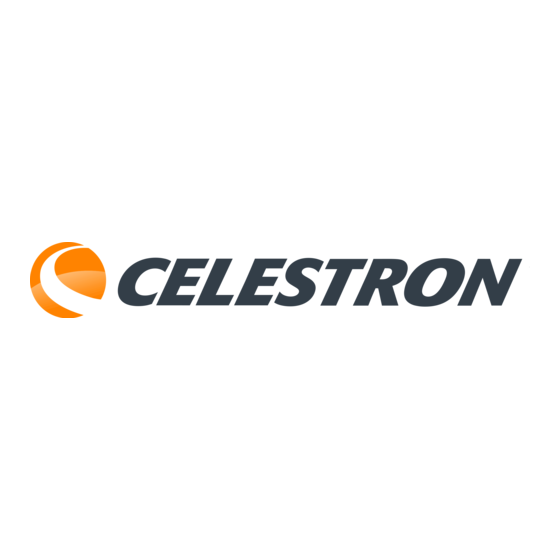
Table of Contents
Advertisement
Quick Links
A
m
b
a
s
s
a
d
o
A
m
b
a
s
s
a
d
o
I
N
S
I
N
S
A
m
b
a
s
s
a
d
o
A
m
b
a
s
s
a
d
o
r
S
e
r
i
e
s
B
r
S
e
r
i
e
s
B
™
™
T
R
U
C
T
I
O
N
T
R
U
C
T
I
O
N
r
5
0
A
Z
#
2
1
0
3
3
A
r
5
0
A
Z
#
2
1
0
3
3
A
r
a
s
s
T
e
l
e
s
r
a
s
s
T
e
l
e
s
M
A
N
U
A
L
M
A
N
U
A
L
m
b
a
s
s
a
d
o
r
8
0
A
Z
#
2
m
b
a
s
s
a
d
o
r
8
0
A
Z
#
2
c
o
p
e
s
c
o
p
e
s
1
0
3
4
1
0
3
4
Advertisement
Table of Contents

Summary of Contents for Celestron Ambassadorr 50AZ
- Page 1 ™ ™...
-
Page 2: Table Of Contents
Table of Contents INTRODUCTION……………………………………………………………………… 3 ASSEMBLY …………………………………………………………………………….6 Setting up the Tripod....................6 Attaching the Telescope and Mount to the Tripod............7 Moving the Telescope Manually................. 8 Installing and Aligning the Finderscope – 80mm model ..........8 Installing the Diagonal & Eyepiece – 80mm model ........... 9 TELESCOPE BASICS …………………………………………………………………10 Focusing ........................ -
Page 3: Introduction
In addition, your telescope is ideal for terrestrial observing. Ambassador telescopes carry a two year limited warranty. For details see our website at www.celestron.com Some of the standard features of the Ambassador include: •... - Page 4 Figure 1-1 Ambassador 50AZ Refractor Objective Lens Tripod Accessory Tray/Brace Telescope Optical Tube Tripod (3 legs) Lens Cap Azimuth Locking Knob Eyepiece Alt-Azimuth Mount Focus Ring Altitude Lock...
- Page 5 Figure 1-2 Ambassador 80AZ Refractor Objective Lens Focus Knob Telescope Optical Tube Tripod Accessory Tray/Brace Finderscope Tripod (3 legs) Finderscope Bracket Azimuth Locking Knob Eyepiece Alt-Azimuth Mount Erect Image Diagonal Altitude Lock...
-
Page 6: Assembly
This section covers the assembly instructions for your Ambassador telescope. Since some parts are heavy (especially on the 80mm model), and you need to be careful not to scratch the brass finish, it is suggested that you have two people work together to assemble the telescope. The various parts for the telescope are wrapped with protective materials and please remove these carefully. -
Page 7: Attaching The Telescope And Mount To The Tripod
Figure 2-6 shows one tripod leg hinge ready to attach to the accessory tray. You can hand tighten the screw with washer initially but once all three leg hinges are attached to the tray, then tighten with a Phillips head screwdriver for the screw while holding the wing nuts with your other hand. Once all the hinges are attached and tightened to the accessory tray, it will look like Figure 2-7. -
Page 8: Moving The Telescope Manually
The Ambassador mount is easy to move wherever you want to point it. The up and down (altitude) is controlled by the altitude lock (Figure 2-12). Loosen the altitude lock by turning it counterclockwise and when at the desired location tighten the lock by turning it clockwise. Note: Before tightening the altitude lock all the way on the 80mm, the target object you are seeking should be located in the finderscope. -
Page 9: Installing The Diagonal & Eyepiece - 80Mm Model
Figure 2-15 Figure 2-16 Figure 2-17 To align the finderscope with the main telescope: Remove the front lens cap of the telescope and both caps from the finderscope. Locate a distant daytime object (at least ¼ mile/0.4km away) and center it in the main telescope. Look through the finderscope (the eyepiece end of the finderscope which has the smaller diameter lens) and take notice of the position of the same object. -
Page 10: Telescope Basics
A telescope is an instrument that collects and focuses light. The nature of the optical design determines how the light is focused. The refractor telescope uses lenses in its optical design. Developed in the early 1600s, the refractor is the oldest telescope design. It derives its name from the method it uses to focus incoming light rays. -
Page 11: Calculating Magnification
32x. You can purchase optional eyepieces (not with a brass finish) to give you higher or lower powers. You can see what is available by looking on the Celestron website. You can change the power of your 80mm telescope just by changing the eyepiece (ocular). To determine the magnification of your telescope, simply divide the focal length of the telescope by the focal length of the eyepiece used. -
Page 12: Celestial Observing
So, avoid observing the planets when they are low on the horizon or when they are directly over a source of radiating heat, such as a rooftop or chimney. To increase contrast and bring out detail on the planetary surface, try using optional Celestron eyepiece filters. -
Page 13: Telescope Maintenance
NOT sealed, the covers should be placed over the openings when not in use. This will prevent contaminants from entering the optical tube. Internal adjustments and cleaning should be done only by the Celestron repair department. If your telescope is in need of internal cleaning, please call the factory for a return authorization number and price quote. - Page 14 Copyright 2007 Celestron - Todos los derechos reservados. Copyright 2007 Celestron - Tous droits réservés. Copyright 2008 Celestron - Tutti i diritti sono riservati. (Products or instructions may change without notice or obligation.) (Produkte oder Anleitung können ohne Mitteilung oder Verpflichtung geändert werden.) (Los productos o instrucciones pueden cambiar sin notificación u obligación).












Need help?
Do you have a question about the Ambassadorr 50AZ and is the answer not in the manual?
Questions and answers